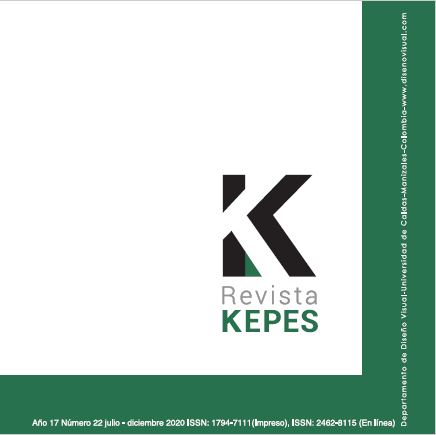Authors
Abstract
Inclusion is defined as the opportunity disabled people have to fully participate in different contexts: education, work, consumption, entertainment, and other daily social activities. For an understanding of that, this study aims at examine the evolution and research trends of the field of inclusive museums in order propose a line of research that includes growing and emerging concepts in this area of knowledge. For that purpose, technological mapping was carried out by means of a bibliometric analysis that examined 284 publications indexed in Scopus from 1987 to 2018. Results indicate that 47 countries have carried out studies on inclusive museums, within the framework of the research lines inclusive education and education in museums. Research that has been disseminated in greater measure through American journals. This bibliometric study on inclusive museums enabled to shed light on the productivity, impact, and networking of researchers in this field. Finally, this study constitutes a relevant starting point that not only presents trends in the field of inclusive museums but also encourages university communities and cultural institutions (such as Latin American museums) to consider the role they play in said area, as well as the visibility of their research efforts.
References
Astudillo, L. (2008). Artists and Craftsmen, a valuable dialog: practical case of an exhibition in the museum of metals. The International Journal of the Inclusive Museum, 1(4), 15-18. https://doi.org/ 10.18848/1835-2014/cgp/v01i04/44538
Bračun, R. (2010). The importance of visitor-focused educational programming for special needs access in museums. The International Journal of the Inclusive Museum, 3(2), 39-48. https://doi.org/10.18848/1835-2014/CGP/v03i02/44323
Bračun Sova, R., & Kemperl, M. (2016). Museum Interpretation as a Didactic Concept: Case Study of the Strossmayer Gallery of Old Masters. Croatian Journal of Education: Hrvatski časopis za odgoj i obrazovanje, 18(4), 969-997. https://doi.org/10.15516/cje.v18i4.2068
Coffee, K. (2007). Audience research and the museum experience as social practice. Museum Management and Curatorship, 22(4), 377-389. https://doi.org/10.1080/09647770701757732
Dawson, E. (2014). Equity in informal science education: developing an access and equity framework for science museums and science centres. Studies in Science Education, 50(2), 209-247. https://doi.org/10.1080/03057267.2014.957558
De La Iglesia-Mayol, B. & Roselló-Ramón, M. (2014). Identificación de las barreras de acceso a la información, a la participación y al aprendizaje en el Museo Es Baluard (Identification of barriers to access to information, participation and learning at the Es Baluard Museum). Arte, Individuo y Sociedad 26(1), 21-38. http://dx.doi.org/10.5209/rev_ARIS.2014.v26.n1.40147
Deng, L. (2016). Inclusive museum and its impact on learning of special needs children. Proceedings of the Association for Information Science and Technology banner, 52(1), 1-4. https://doi.org/10.1002/pra2.2015.1450520100110
Dias, A. & César, M. (2014). Museums as spaces and times for learning and social participation. Psychology in Russia: State of the Art, 7(4),20-34. https://doi.org/10.11621/pir.2014.0402
Fontal, O. (2008). Museums as creators of identity: Keys to an inclusive museology in contemporary art museums. The International Journal of the Inclusive Museum 1(1), 89-96. https://10.18848/1835-2014/CGP/v01i01/44283
Galla, A. (2012). El museo inclusivo (The inclusive museum). In: E. Varela (ed.). museos.es (pp. 40-53) Madrid, España: Ministerio de Educación, Cultura y Deporte. Retrieved from: http://nuevamuseologia.net/wp-content/uploads/2016/01/museus910.pdf
García, I. (2015). The role of museums in contemporary society: Institutional discourse or participatory museum. Complutum, 26(2), 39-47. https://doi.org/10.5209/rev_CMPL.2015.v26.n2.50415
Gusdorf, G. (1983). Pasado, presente y futuro de la investigación interdisciplinaria (Past, present and future of interdisciplinary research). In: T. Bottomore (coord.). Interdisciplinariedad y ciencias humanas (pp. 32-52). España: Tecnos Ediciones UNESCO
Hamidi, J. (2016). Modifying the development model for an inclusive museum to realise a miniature of good village governance (a study on indigenous people of tengger and baduy). Pertanika Journal of Social Sciences and Humanities, 24(2),721-736. https://www.cabdirect.org/cabdirect/abstract/20163201561
Johnston, R. (2008). Engaging children online: is there room for the grittiness of social reality? The International Journal of the Inclusive Museum, 1(1), 83-88. https://doi.org/10.18848/1835-2014/CGP/v01i01/44343
Louderback, P. (2017). Inclusive education practices for a culturally responsive teacher education program. In International Conference on Information Society (i-Society), 155-160. Dublin, Ireland: IEEE.
Maleuvre, D. (2012). Must museums be inclusive? Journal of Educational Media, Memory and Society, 4(2), 112-125. https://doi.org/10.3167/jemms.2012.040207
Monteiro, L. (2008). Including immigrants: How art museums can bring together old and new Americans. The International Journal of the Inclusive Museum 1(4), 139-146. https://doi.org/10.18848/1835-2014/CGP/v01i04/44546
Moore, P. (2016). The Inclusive Museum Movement Creating a more inclusive, equitable, and culturally responsible museum field. Retrieved from: https://www.bluetoad.com/publication/?i=357034&article_id=2637915&view=articleBrowser&ver=html5
Parra, C. (2011). Educación inclusiva: un modelo de diversidad humana (Inclusive education: a model of human diversity). Revista Educación y Desarrollo Social, 1: 139-150. Retrieved from: https://dialnet.unirioja.es/descarga/articulo/5386258.pdf
Peralta, M., Frías, M. & Chaviano, O. (2015). Criterios, clasificaciones y tendencias de los indicadores bibliométricos en la evaluación de la ciencia (Criteria, classifications and trends of bibliometric indicators in the evaluation of science). Revista Cubana de Información en Ciencias de la Salud, 26(3), 290-309. Retrieved from: http://scielo.sld.cu/pdf/ics/v26n3/rci09315.pdf
Randolph, D. & Rowson, A. (2012). Does cosmopolitanism offer answers to inclusive practices in the art museum? A New Orleans art museum as case study. International Journal of the Inclusive Museum, 4(2), 37-47. https://doi.org/10.18848/1835-2014/CGP/v04i02/44372
Riviére, G. H. (1989). La museología: curso de museología: textos y testimonios (Museology: museology course: texts and testimonies). Barcelona, España: Ediciones AKAL.
Shepherd, H. (2009). Focus on practice: Inclusion and museums: developing inclusive practice. British Journal of Special Education, 36(3),140-145. https://doi.org/10.1111/j.1467-8578.2009.00437.x
Smith, E. (2010). Engaging the visitor: Architectural rhetoric and the inclusive art museum. International Journal of the Inclusive Museum, 3(3), 15. https://doi.org/10.18848/1835-2014/CGP/v03i03/44330
Thompson, S. (2012). The United Arab Emirates and the Emerging Museum Website. International Journal of the Inclusive Museum, 4(3), 39-49. https://doi.org/10.18848/1835-2014/CGP/v04i03/44375.
Vemi, V. & Kanari, H. (2008). School teachers and museum education: A key factor in expanding the inclusive character of museums. International Journal of the Inclusive Museum, 1(3), 1-8. https://doi.org/10.18848/1835-2014/CGP/v01i03/44523
Vergo, P. (1989). The new museology. London, United Kingdom: Reaktion Books Ltd. Britain.
Weiland, I. (2014). An exploration of hispanic mothers’ culturally sustaining experiences at an informal science center. Journal of Research in Science Teaching, 52(1), 84-106. https://doi.org/10.1002/tea.21190
Wylder, V. & Meale M. (2009). The Story Project: A Model for Achieving Profound Inclusion in Museums. The International Journal of the Inclusive Museum, 2(1): 109-124. https://doi.org/10.18848/1835-2014/CGP/v02i01/44553

 pdf (Español (España))
pdf (Español (España))
 FLIP
FLIP






















